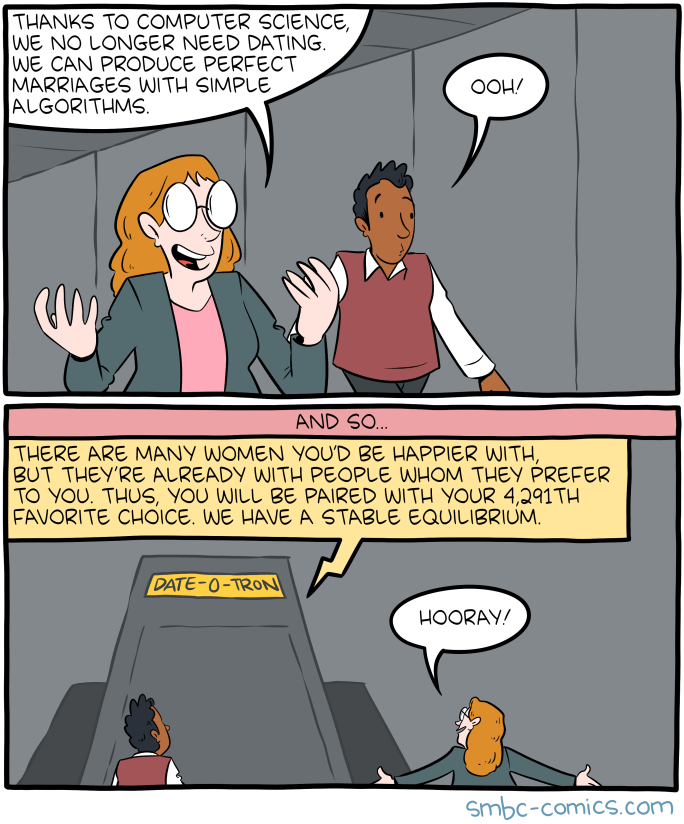. (It contains abstracts following the schedule...)
14:15 - 14:40“Stability Against Robust Deviations in the Roommate Problem”Daisuke Hirata, Yusuke Kasuya, andKentaro Tomoeda
14:40 - 15:05“Robust Group Strategy-Proofness”Steven KivinenandNorovsambuu Tumennasan
15:05 - 15:30“Robust Design in Monotonic Matching Markets: A Case for Firm-Proposing Deferred-Acceptance”Lars Ehlersand Jordi Masso
“Preprocessing in Matching Problems” Maxence Delorme, Ser-gio Garc`ıa, Jacek Gondzio, Joerg Kalcsics, David Manlove, andWilliam Pettersson
“Legal Assignments, the EADAM (Efficiency Adjusted DeferredAcceptance Mechanism) Algorithm” Yuri Faenza andXuanZhang
“A General Framework for Stable Roommate Problems: A Preliminary Report”Muge Fidan and Esra Erdem
“Preference Manipulation in Two-Sided Matching - Strategic Behavior and Robustness of Solution Algorithms” Christian Haas
“Practical Issues in Matching - A Case Study on Genetic Counseling Admissions in North America” Jonah Peranson
“Unpopularity Factor in the Marriage and Roommates Problems”Suthee Ruangwises and Toshiya Itoh
“School choice with priority levels: Constrained Efficient and FairAssignment” Thomas Wouters
09:10 CSF Welcome Address
09:25 - 10:10 Invited Talk“Parameterizing Stable Matching Problems” Ildi Schlotter
10:10 - 10:35“Stable Noncrossing Matchings” Suthee Ruangwises and Toshiya Itoh
10:35 - 11:05 Coffee Break
11:05 - 11:30 “Refugee Resettlement” David Delacretaz, Scott Duke Kominers, and Alexander Teytelboym
11:30 - 11:55 “Matching Problem of Civil Service”Ashutosh Thakur
11:55 - 12:20 “Trading Networks with General Preferences” Jan Christoph Schlegel
12:20 - 13:45 Lunch
13:45 - 14:30 Invited Talk “International Kidney Exchange Programmes: Op-timisation and Games”Peter Biro
14:30 - 14:55 “Pareto Optimal Coalitions of Fixed Size” ́Agnes Cseh, Tam ́as Fleiner, and Petra Harjan
14:55 - 15:20 “Balanced Stable Marriage: How Close is Close Enough?” Sushmita Gupta, Sanjukta Roy, Saket Saurabh, and Meirav Zehavi
15:20 - 15:50 Coffee Break
15:50 - 16:15“Flexibility in House Allocation and Housing Markets” Madhav Raghavan
16:15 - 16:40 “Endowment Manipulations in Probabilistic Assignment Problem”Yuki Tamura
16:40 - 17:05“Equivalent Choice Functions and Stable Mechanisms” Jan Christoph Schlegel
17:05 - 17:15 Short Break (no coffee)
17:15 - 17:40 “Centralized Matching with Incomplete Information” Marcelo Ariel Fernandezand Leeat Yariv
17:40 - 18:05“Simultaneous Search: Beyond Independent Successes” Ran I.Shorrer
18:05 - 18:30 “Deferred Acceptance and Regret-free Truth-telling: A Character-ization Result” Marcelo Ariel Fernandez
Tuesday, May 28
09:00 - 09:45 Invited Talk “Balanced Exchange in a Multi-Object Shapley-Scarf Market” P ́eter Biro,Flip Klijn, and Szilvia Papai
09:45 - 10:10 “Competing for Priorities in School Choice” Greg Leo and MartinVan der Linden
10:10 - 10:35 “Information Acquisition Costs in Matching Markets” Nicole S. Immorlica, Jacob D. Leshno, and Irene Y. Lo
10:35 - 11:05 Coffee Break
11:05 - 11:30 “Efficient and (Pretty) Fair Course Assignment with Quotas” Martin Bichler, Alexander Hammerl, Thayer Morrill, and StefanWaldherr
11:30 - 11:55 “An Algorithm for Strong Stability in the Student-Project Alloca-tion Problem with Ties” Sofiat Olaosebikan and David Manlove
11:55 - 12:20“Strategy-Proof Approximation Algorithms for the Stable Mar-riage Problem with Ties and Incomplete Lists”, Koki Hamada, Shuichi Miyazaki, and Hiroki Yanagisawa
Wednesday, May 29th
09:00 - 09:45 Invited Talk “Efficient and Incentive-Compatible Liver Ex-change” Haluk Ergin, Tayfun Sonmez, andM. Utku Unver
09:45 - 10:10 “Matching for the Israeli “Mechinot” Gap-Year Programs: Handling Rich Diversity Requirements” Yannai A. Gonczarowski, Lior Kovalio, Noam Nisan, and Assaf Romm
10:10 - 10:35 “Recourse in Kidney Exchange Programs” Valentin Bartier, Yves Crama, Bart Smeulders, and Frits C.R. Spieksma
10:35 - 11:05 Coffee Break
11:05 - 11:30 “Obvious Dominance and Random Priority” Marek Pycia and Peter Troyan
11:30 - 11:55 “Subgame Perfect Equilibria under the Deferred Acceptance Algo-rithm” Keisuke Bando andYasushi Kawase
11:55 - 12:20 “Optimizing Reserves in School Choice: A Dynamic ProgrammingApproach” Franklyn Wang, Ravi Jagadeesan, and Scott Duke Kominers
12:20 - 13:45 Lunch
13:45 - 14:10 “Strategy-proof, Envy-free and Pareto Efficient Online Mecha-nisms for Fair Division with Additive Valuations” Martin Aleksandrov and Toby Walsh
14:10 - 14:35 “An Alternative Approach to Asylum Assignment” Gian Caspari
14:35 - 15:00 “Matching with Myopic and Farsighted Players” Jean-Jacques Herings, Ana Mauleon, and Vincent Vannetelbosch
15:00 - 15:30 Coffee Break
15:30 - 16:15 Invited Talk “Pareto Optimal Allocation under Uncertain Pref-erences” Haris Aziz, Peter Bir ́o, Ronald de Haan, and Baharak Rastegari
16:15 - 16:40 CSF Award and Algorithms Award
16:40 - 18:00 Poster Presentation Session 2A
ll papers as in Poster Presentation Session 1 (except for Jonah Peranson and Christian Haas).
19:00Dinner











